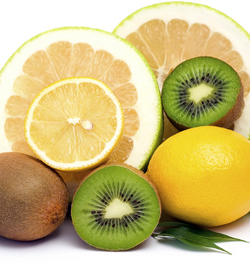You have no items in your shopping cart.
Problems Adding to Cart? Click here for assistance.

Vitamin C is hot – and not just because Dr Oz has endorsed it as an anti-ager. There have been huge advances in the formulation of vitamin C and its derivatives. The good news is that these new forms of vitamin C are stable, powerful and relatively gentle – certainly when compared to plain vanilla ascorbic acid. The bad news is that it is headache-inducing to try to make sense of the different types of vitamin C, their relative advantages and optimal concentrations. So, to help you choose the right one for you, here’s a round up of vitamin Cs and where to find them (oh and you might enjoy our recommended Five Best Serums with Vitamin C 2014).
This is your basic vitamin C and responsible for vitamin C’s bad rap. It is unstable (it will oxidize in light and needs to be kept in dark bottles), does not absorb well and therefore needs to be used at high concentrations that can result in a formula that is drying and irritating. For maximum effectiveness, formulas should be at high concentrations (10%+) and with low pH levels (<3.5).
A good solution for ascorbic acid’s limitations is to encapsulate the vitamin C in liposomes to stabilize the vitamin C and ensure that it is delivered more efficiently into the cells (they also prevent adverse interaction with the copper pca that is also part of the formulation). I can attest to the stability – liposome vitamin C is in E’shee Serum Vitalizing C ($119 in the shop) – this vitamin C serum lasts for months and months without oxidating
Sodium ascorbyl phosphate is a fairly new form of vitamin C that is known as Stay C 50. There is some evidence that it can improve acne and acne scarring (where as ascorbic acid has been shown to cause acne), and is an effective antioxidant and collagen stimulator.
It is stable in aqueous formulations in part because it is not activated until it is absorbed into the skin convert to ascorbic acid, which is why you will not see it oxidized in the bottle.
The final concentration of sodium ascorbyl phosphate in end-use products could be up to 5% depending on the application. In Mad Hippie’s Vitamin C Serum ($34 in the shop), there is 9-10% sodium ascorbyl phosphate. The company claims that, given the greater bioavailablilty, this would compare to around a 20% concentration of ascorbic acid. You will also find sodium ascorbyl phosphate in Lather’s 10-minute Brightening Mask ($28 in the shop), MAD’s Brightening series including the MAD Radiant Brightening Mask ($38 in the shop), which has the MAD signature vitamin C complex (Stay C 50, ascorbyl glucoside and magnesium ascorbyl phosphate).
In one study I found (which was published in a reputable journal) tetrahexydecyl ascorbate is described as "a new active lipid form of pro-vitamin C" with "increased ability to penetrate" and convert to vitamin C within the dermis ... [and] superior stability to ascorbic acid."
All this means that tetra is effective at low concentrations and ideal for those with sensitive skin. For example, Medik8 C-Tetra Pro-Collagen Vitamin C Formula ($70 in the shop) has 3% tetrahexyldecyl ascorbate and Medik8 CE-Tetra Pro-Collagen Synthesis Super Antioxidant Serum ($115 in the shop) has 7%. It can also be found in Osmotics Micro Peel Resurfacing System ($86 in the shop), as well as the above mentioned MAD Radiant Brightening Mask ($38 in the shop).
AKA MAP, magnesium ascorbyl phosphate is water-soluble, but found to be more gentle on the skin than ascorbic acid, effective in significantly lower concentrations, and stable at a neutral pH. For example: Like ascorbic acid, it shows suppression of melanin formation by inhibition of tyrosine. One study found that it needs to be at 10% concentration to suppress melanin formation.
What's more, it keeps up to 60-75% of its stability after 365 days of storage in the dark, and has compelling evidence behind it that it does indeed cross the epidermis where it is effectively converted into ascorbic acid where it is able to promote collagen synthesis and wound healing, lighten skin pigmentation, and protect against UVB induced tumor formation in the skin.
MAP is in Eslor Active Night Cream ($95 in the shop) and Eslor Firming Eye Cream ($75) and Nutra-Lift Maximum C ($36 in the shop)
Aminopropyl ascorbyl phosphate/AAP, is a relatively new derivative of Vitamin C, that is often preferred for having superior stability and effectiveness. It’s particularly lauded for reducing melanin production – the culprit behind age spots, melasma and hyperpigmentation.
Along with tetra and MAP, you’ll find aminopropyl ascorbyl phosphates in Your Best Advanced CE Concentrate ($50 in the shop).
Related posts:
Five Best Serums with Vitamin C 2014
Part 1: What is it? Vitamin C: An Investigation & Discussion
Part 2: What is it? Vitamin C: What it does for your skin
Part 3: What is it? Vitamin C as L-ascorbic acid
Part 4: What is it? Vitamin C derivatives
Your Skin Care Vitamin Guide



